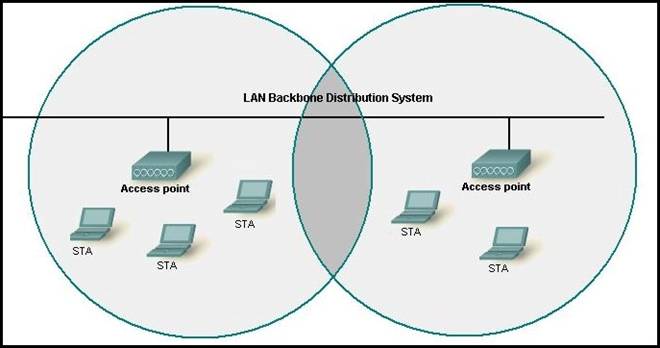CCNA – Wireless
Here you will find answers to CCNA Wireless Questions
If you are not sure about Wireless, please read my Wireless tutorial and Basic Wireless Terminologies
Question 1
Which additional configuration step is necessary in order to connect to an access point that has SSID broadcasting disabled?
A. Set the SSID value in the client software to public.
B. Configure open authentication on the AP and the client.
C. Set the SSID value on the client to the SSID configured on the AP.
D. Configure MAC address filtering to permit the client to connect to the AP.
Answer: C
Question 2
What is one reason that WPA encryption is preferred over WEP?
A. A WPA key is longer and requires more special characters than the WEP key.
B. The access point and the client are manually configured with different WPA key values.
C. WPA key values remain the same until the client configuration is changed.
D. The values of WPA keys can change dynamically while the system is used.
Answer: D
Question 3
Which two devices can interfere with the operation of a wireless network because they operate on similar frequencies? (Choose two)
A. copier
B. microwave oven
C. toaster
D. cordless phone
E. IP phone
F. AM radio
Answer: B D
Question 4
A single 802.11 g access point has been configured and installed in the center of a square office. A few wireless users are experiencing slow performance and drops while most users are operating at peak efficiency. What are three likely causes of this problem? (Choose three)
A. mismatched TKIP encryption
B. null SSID
C. cordless phones
D.mismatched SSID
E. metal file cabinets
F. antenna type or direction
Answer: C E F
Question 5
Refer to the exhibit. What two facts can be determined from the WLAN diagram? (Choose two)

A. The area of overlap of the two cells represents a basic service set (BSS).
B. The network diagram represents an extended service set (ESS).
C. Access points in each cell must be configured to use channel 1.
D. The area of overlap must be less than 10% of the area to ensure connectivity.
E. The two APs should be configured to operate on different channels.
Answer: B E
Explanation
A group of access points connected to the same WLAN are known as an Extended Service Set (ESS). Within an ESS, a client can associate with any one of many access points that use the same Extended service set identifier (ESSID). It allows users to roam about an office without losing wireless connection -> B is correct.
Two APs operating near each other should be configured on different channels to avoid interference. There are fourteen channels defined in the IEEE 802.11b channel set. Each channel is 22MHz wide but there is only 5MHz channel separation so the channels are overlapped. Channels 1, 6 and 11 are most commonly used because they do not overlap as shown below:

So if we configure an AP with channel 1 then we should set its nearest AP to channel 6 or 11 to make sure their channels are not overlapped.
Question 6
What are three basic parameters to configure on a wireless access point? (Choose three)
A. SSID
B. RTS/CTS
C. AES-CCMP
D. TKIP/MIC
E. RF channel
F. authentication method
Answer: A E F
Question 7
What speeds must be disabled in a mixed 802.11 b/g WLAN to allow only 802.11 g clients to connect?
A. 6,9,12,18
B. 1,2,5.5,6
C. 5.5,6,9,11
D. 1,2,5.5,11
Answer: D
Explanation
The data rates of 802.11b are 1, 2, 5.5 and 11 Mbps using Direct Sequence Spread Spectrum (DSSS) while the data rates of 802.11g are 1, 2, 5.5, 11 Mbps using DSSS and 6, 9, 12, 18, 24, 36, 48, 54 Mbps using OFDM. So if we only want to allow 802.11g clients, just disable 1, 2, 5.5 and 11 Mbps speed.
Question 8
What is the maximum data rate specified for IEEE 802.11b WLANs?
A. 10 Mbps
B. 11 Mbps
C. 54 Mbps
D. 100 Mbps
Answer: B
Question 9
A wireless client cannot connect to an 802.11 b/g BSS with a b/g wireless card. The client section of the access point does not list any active WLAN clients. What is a possible reason for this?
A. The incorrect channel is configured on the client.
B. The client’s IP address is on the wrong subnet.
C. The client has an incorrect pre-shared key.
D. The SSID is configured incorrectly on the client.
Answer: D
Question 10
Which two features did WPAv1 add to address the inherent weaknesses found in WEP? (Choose two)
A. a stronger encryption algorithm
B. key mixing using temporal keys
C. shared key authentication
D. a shorter initialization vector
E. per frame sequence counters
Answer: B E
Question 11
What is the maximum data rate specified for IEEE 802.11b WLANs?
A. 10Mbps
B. 11Mbps
C. 54Mbps
D. 100Mbps
Answer: B
Explanation
Popular wireless standards are listed below:
* IEEE 802.11a: 54 Mbps in the 5.7 GHz ISM band
* IEEE 802.11b: 11 Mbps in the 2.4 GHz ISM band
* IEEE 802.11g: 54 Mbps in the 2.4 GHz ISM band
Question 12
You have finished physically installing an access point on the ceiling at your office. At a minimum, which parameter must be configured on the access point in order to allow a wireless client to operate on it?
A. AES
B. PSK
C. SSID
D. TKIP
E. WEP
Answer: C


